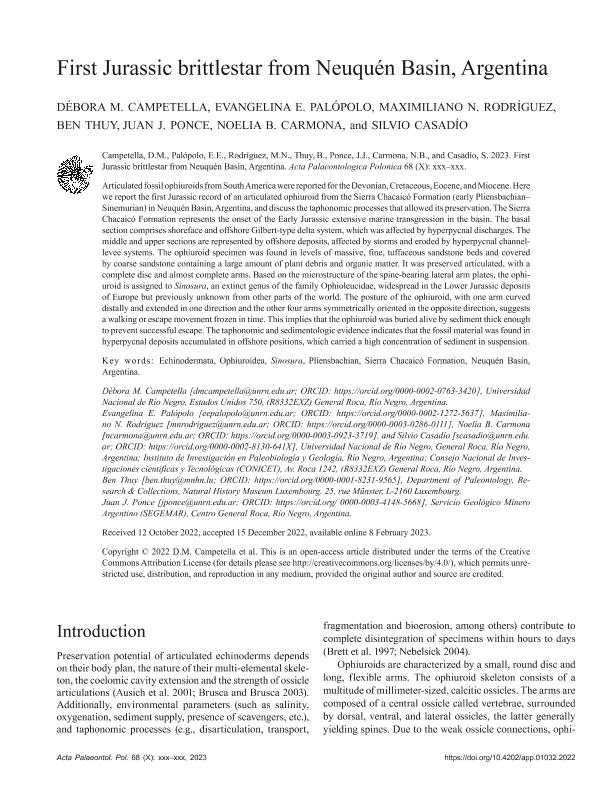Mostrar el registro sencillo del ítem
dc.contributor.author
Campetella, Débora Mical

dc.contributor.author
Palópolo, Evangelina Elizabeth

dc.contributor.author
Rodriguez, Maximiliano
dc.contributor.author
Thuy, Ben
dc.contributor.author
Ponce, Juan Jose

dc.contributor.author
Carmona, Noelia Beatriz

dc.contributor.author
Casadio, Silvio Alberto

dc.date.available
2023-12-01T15:02:59Z
dc.date.issued
2023-02
dc.identifier.citation
Campetella, Débora Mical; Palópolo, Evangelina Elizabeth; Rodriguez, Maximiliano; Thuy, Ben; Ponce, Juan Jose; et al.; First Jurassic brittlestar from Neuquén Basin, Argentina; Polish Academy of Sciences. Institute of Paleobiology; Acta Palaeontologica Polonica; 68; 2-2023; 143-153
dc.identifier.issn
0567-7920
dc.identifier.uri
http://hdl.handle.net/11336/219007
dc.description.abstract
Articulated fossil ophiuroids from South America were reported for the Devonian, Cretaceous, Eocene, and Miocene. Here we report the first Jurassic record of an articulated ophiuroid from the Sierra Chacaicó Formation (early Pliensbachian–Sinemurian) in Neuquén Basin, Argentina, and discuss the taphonomic processes that allowed its preservation. The Sierra Chacaicó Formation represents the onset of the Early Jurassic extensive marine transgression in the basin. The basal section comprises shoreface and offshore Gilbert-type delta system, which was affected by hyperpycnal discharges. The middle and upper sections are represented by offshore deposits, affected by storms and eroded by hyperpycnal channel-levee systems. The ophiuroid specimen was found in levels of massive, fine, tuffaceous sandstone beds and covered by coarse sandstone containing a large amount of plant debris and organic matter. It was preserved articulated, with a complete disc and almost complete arms. Based on the microstructure of the spine-bearing lateral arm plates, the ophiuroid is assigned to Sinosura, an extinct genus of the family Ophioleucidae, widespread in the Lower Jurassic deposits of Europe but previously unknown from other parts of the world. The posture of the ophiuroid, with one arm curved distally and extended in one direction and the other four arms symmetrically oriented in the opposite direction, suggests a walking or escape movement frozen in time. This implies that the ophiuroid was buried alive by sediment thick enough to prevent successful escape. The taphonomic and sedimentologic evidence indicates that the fossil material was found in hyperpycnal deposits accumulated in offshore positions, which carried a high concentration of sediment in suspension.
dc.format
application/pdf
dc.language.iso
eng
dc.publisher
Polish Academy of Sciences. Institute of Paleobiology

dc.rights
info:eu-repo/semantics/openAccess
dc.rights.uri
https://creativecommons.org/licenses/by-nc-sa/2.5/ar/
dc.subject
ARGENTINA
dc.subject
ECHINODERMATA
dc.subject
NEUQUÉN BASIN
dc.subject
OPHIUROIDEA
dc.subject
PLIENSBACHIAN
dc.subject
SIERRA CHACAICÓ FORMATION
dc.subject
SINOSURA
dc.subject.classification
Paleontología

dc.subject.classification
Ciencias de la Tierra y relacionadas con el Medio Ambiente

dc.subject.classification
CIENCIAS NATURALES Y EXACTAS

dc.title
First Jurassic brittlestar from Neuquén Basin, Argentina
dc.type
info:eu-repo/semantics/article
dc.type
info:ar-repo/semantics/artículo
dc.type
info:eu-repo/semantics/publishedVersion
dc.date.updated
2023-11-28T14:48:09Z
dc.identifier.eissn
1732-2421
dc.journal.volume
68
dc.journal.pagination
143-153
dc.journal.pais
Polonia

dc.journal.ciudad
Varsovia
dc.description.fil
Fil: Campetella, Débora Mical. Consejo Nacional de Investigaciones Científicas y Técnicas. Centro Científico Tecnológico Conicet - Patagonia Norte. Instituto de Investigación en Paleobiología y Geología; Argentina. Universidad Nacional de Río Negro; Argentina
dc.description.fil
Fil: Palópolo, Evangelina Elizabeth. Consejo Nacional de Investigaciones Científicas y Técnicas. Centro Científico Tecnológico Conicet - Patagonia Norte. Instituto de Investigación en Paleobiología y Geología; Argentina
dc.description.fil
Fil: Rodriguez, Maximiliano. Consejo Nacional de Investigaciones Científicas y Técnicas. Centro Científico Tecnológico Conicet - Patagonia Norte. Instituto de Investigación en Paleobiología y Geología; Argentina
dc.description.fil
Fil: Thuy, Ben. Musee National de Luxembourg; Luxemburgo
dc.description.fil
Fil: Ponce, Juan Jose. Consejo Nacional de Investigaciones Científicas y Técnicas. Centro Científico Tecnológico Conicet - Patagonia Norte. Instituto de Investigación en Paleobiología y Geología; Argentina. Servicio Geologico Minero Argentino. Delegacion General Roca.; Argentina
dc.description.fil
Fil: Carmona, Noelia Beatriz. Consejo Nacional de Investigaciones Científicas y Técnicas. Centro Científico Tecnológico Conicet - Patagonia Norte. Instituto de Investigación en Paleobiología y Geología; Argentina
dc.description.fil
Fil: Casadio, Silvio Alberto. Consejo Nacional de Investigaciones Científicas y Técnicas. Centro Científico Tecnológico Conicet - Patagonia Norte. Instituto de Investigación en Paleobiología y Geología; Argentina
dc.journal.title
Acta Palaeontologica Polonica

dc.relation.alternativeid
info:eu-repo/semantics/altIdentifier/url/https://www.app.pan.pl/article/item/app010322022.html
dc.relation.alternativeid
info:eu-repo/semantics/altIdentifier/doi/http://dx.doi.org/10.4202/app.01032.2022
Archivos asociados
